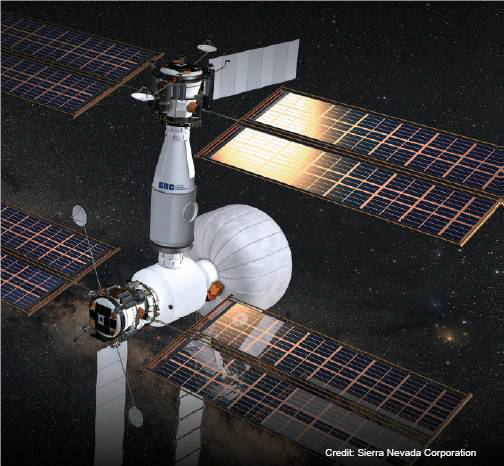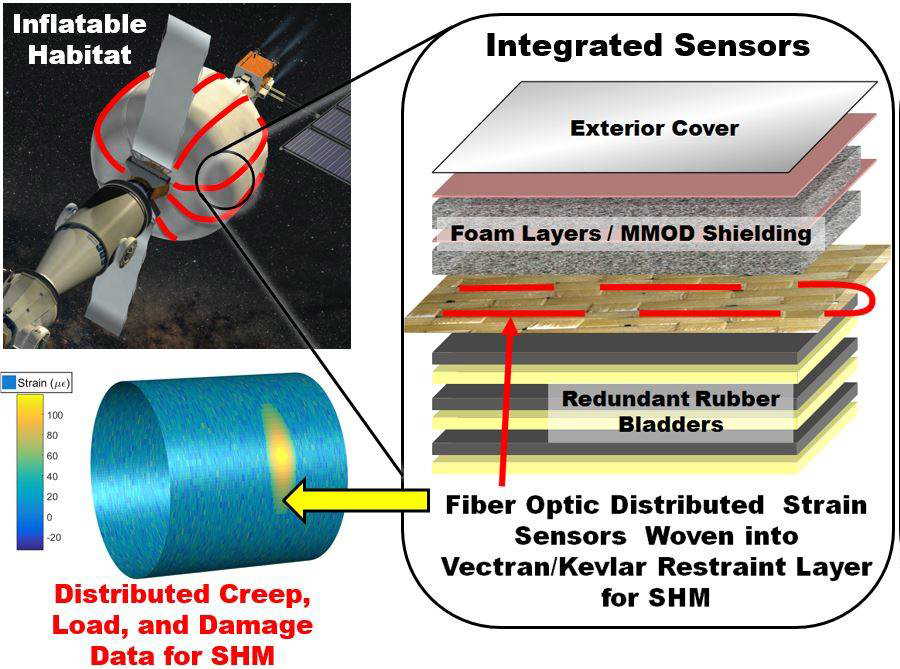Innovative Sensors for Inflatable Space Habitats
Working to get Luna fiber optic sensors into space
Luna is working on a research project in collaboration with NASA, Sierra Nevada Corporation (SNC), and ILC Dover to develop an approach for structural health monitoring of inflatable space habitats using our innovative high-definition fiber optic sensing (HD-FOS). This team of industry partners are the leading candidates for deploying these inflatable structures into orbit as a component of NASA’s Moon to Mars Exploration Campaign plan, a NASA-led initiative seeking to send humans deeper into space thereby bringing back newfound knowledge and opportunities.

Motivated by the Moon to Mars Exploration Campaign, Luna hopes that the results of this research will reveal its sensors as suitable instruments for the inflatable space habitats. According to John Ohanian, Luna’s principal investigator on the project, our sensors might address a variety of applications as part of this initiative. He explains, “One of the first places our technology could fit in is on the Lunar Gateway (see Figure 1) - a depot that will be orbiting the moon and a staging point for going to Mars. A habitation module in the gateway could be an inflatable habitat. Inflatables could also be used in transit to Mars or on the surface of the Moon or Mars.” Inflatable habitats are highly versatile and provide the most living space per unit weight compared to all other approaches in consideration--though they also have their own set of challenges.
Inflatable habitats are favorable for space travel because they alleviate the weight and cost constraints; however, it is difficult to reliably monitor their structural health, which is essential to astronaut safety. Ohanian explains, “Putting sensors in highly flexible materials is very challenging because you can’t use the typical ways of measuring strain. Traditionally, you glue strain gages to rigid structures, but that does not work for these softgoods structures, which are made from flexible webbings, making it challenging to collect meaningful data to give an early warning of a potential failure in the material.”
These structures are prone to two main detrimental risks: creep and micrometeoroid impacts. Creep refers to strain growth over a long period of time, while micrometeoroids are small rocks which can weaken or puncture the fabric used in the inflatable space habitat. Both challenges would endanger astronauts’ lives. When the stakes for failure are that high, a greater degree of certainty is required.

Cementing Luna’s reputation as a thought-leader for innovative design approaches, the Luna team has discovered a solution to this SHM obstacle: by embedding our sensors into the flexible webbing itself, we eliminate the need for external sensor gages (see Figure 2). “As far as embedded sensors go, we come up with all sorts of innovative approaches,” says Ohanian. “At a high-level our sensing technology has addressed the two highest risk modes for inflatable space habitats: creep and micrometeoroid impacts.” Ohanian recently presented a technical paper on this topic at ASCEND 2020, a space-focused conference and symposium hosted by the American Institute of Aeronautics and Astronautics (AIAA).
By embedding sensors into the webbing of the inflatable space habitats, Luna has succeeded in providing unprecedented data quality for real-time, long-duration monitoring of the softgoods structure. With the success of the technology’s performance in a series of laboratory damage tests, creep tests, and simulated micrometeoroid impacts, Luna is excited to bring this innovative discovery to the next level. A NASA Tipping Point project is underway to test the sensors in a more realistic structure at 1/3-scale during ground testing. If our sensors are proven successful, they could be included in future space mission habitat structures such as the Lunar Gateway and even transit and orbital habitats for Mars missions.
For more technical detail, the paper is available here. A recorded video presentation is also available here.